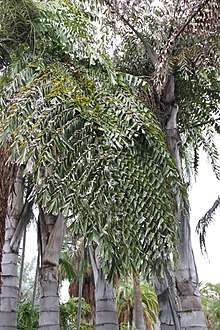Caryoteae
Caryoteae is a tribe in the palm family Arecaceae, distributed across Southeast Asia, from southern India and Sri Lanka east to Vanuatu and northern-most Queensland, Australia. It was long considered a member of subfamily Arecoideae on the basis of its inflorescences, which resemble those of tribe Iriarteeae, and the flowers arranged in triads (two male flowers with a central female flower), which are common across Arecoideae.[1] However, phylogenetic studies based on DNA repeatedly link Caryoteae to subfamily Coryphoideae. Caryoteae do have leaves with induplicate folds, a feature found in most Coryphoid palms, but unlike most Coryphoideae, the leaves are pinnate (Arenga, Wallichia) or bipinnate (Caryota).[2][3] Phoenix is the only other Coryphoid genus with induplicate, pinnate leaves.[3]
| Caryoteae | |
|---|---|
 | |
| Caryota gigas at the Huntington Library | |
| Scientific classification | |
| Kingdom: | Plantae |
| Clade: | Tracheophytes |
| Clade: | Angiosperms |
| Clade: | Monocots |
| Clade: | Commelinids |
| Order: | Arecales |
| Family: | Arecaceae |
| Subfamily: | Coryphoideae |
| Tribe: | Caryoteae Scheff. |
| Type genus | |
| Caryota | |
| Genera | |
Gallery
 The bipinnate leaves of Caryota mitis
The bipinnate leaves of Caryota mitis Caryota flowers are arranged in triads
Caryota flowers are arranged in triads- Caryota urens flowers at anthesis
 The fruits of Caryota mitis
The fruits of Caryota mitis Fruits of Arenga engleri
Fruits of Arenga engleri.jpg) Arenga leaves are pinnate
Arenga leaves are pinnate Leaves of Arenga undulatifolia - note the praemorse margins
Leaves of Arenga undulatifolia - note the praemorse margins.jpg) Young specimen of Arenga engleri
Young specimen of Arenga engleri Wallichia disticha leaves are arranged in two ranks
Wallichia disticha leaves are arranged in two ranks The flowers of Wallichia oblongifolia
The flowers of Wallichia oblongifolia
References
- Uhl, Natalie W.; Dransfield, John (1987). Genera Palmarum: a classification of palms based on the work of Harold E. Moore Jr. Lawrence, Kansas, U.S.A.: The L. H. Bailey Hortorium and the International Palm Society. ISBN 9780935868302.
- Dransfield, John; Uhl, Natalie W.; Asmussen, Conny B.; Baker, William J.; Harley, Madeline M.; Lewis, Carl E. (2005). "A new phylogenetic classification of the palm family, Arecaceae". Kew Bulletin. 60: 559–569 – via ResearchGate.
- Dransfield, John; Uhl, Natalie W.; Asmussen, Conny B.; Baker, William J.; Harley, Madeline M.; Lewis, Carl E. (2014). Genera Palmarum: The Evolution and Classification of Palms. International Palm Society. ISBN 978-1842461822.
External links
